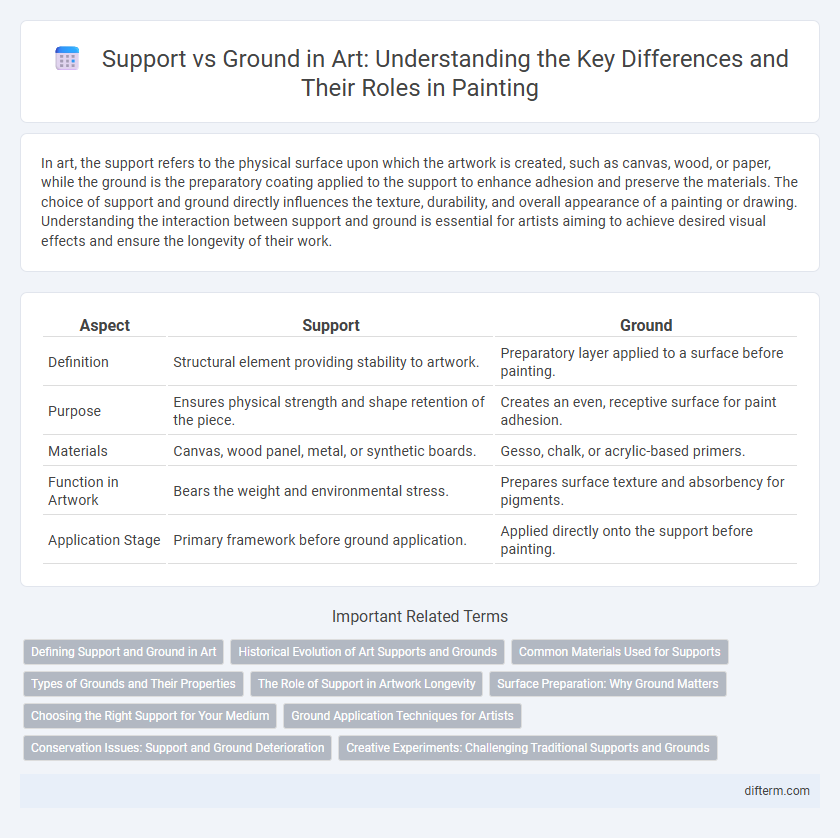In art, the support refers to the physical surface upon which the artwork is created, such as canvas, wood, or paper, while the ground is the preparatory coating applied to the support to enhance adhesion and preserve the materials. The choice of support and ground directly influences the texture, durability, and overall appearance of a painting or drawing. Understanding the interaction between support and ground is essential for artists aiming to achieve desired visual effects and ensure the longevity of their work.
Table of Comparison
| Aspect | Support | Ground |
|---|---|---|
| Definition | Structural element providing stability to artwork. | Preparatory layer applied to a surface before painting. |
| Purpose | Ensures physical strength and shape retention of the piece. | Creates an even, receptive surface for paint adhesion. |
| Materials | Canvas, wood panel, metal, or synthetic boards. | Gesso, chalk, or acrylic-based primers. |
| Function in Artwork | Bears the weight and environmental stress. | Prepares surface texture and absorbency for pigments. |
| Application Stage | Primary framework before ground application. | Applied directly onto the support before painting. |
Defining Support and Ground in Art
Support in art refers to the physical surface or material on which an artwork is created, such as canvas, wood panel, or paper, providing structural stability. Ground is the preparatory coating applied to the support, often made of gesso or primer, designed to create an ideal surface texture and absorbency for painting or drawing media. Understanding the relationship between support and ground is essential for preserving the integrity and appearance of artworks, as each influences the behavior of pigments and the durability of the finished piece.
Historical Evolution of Art Supports and Grounds
Art supports and grounds have evolved significantly from ancient frescoes where lime plaster served as the ground to medieval panel paintings utilizing gesso on wood panels as the support. The Renaissance period marked a pivotal shift with the introduction of stretched linen canvases primed with lead white, improving paint adhesion and longevity. Modern art expanded the variety of supports and grounds to include synthetic materials and prepared surfaces, reflecting innovations in artistic techniques and the quest for new textures.
Common Materials Used for Supports
Common materials used for supports in art include canvas, wood panels, paper, and metal sheets, providing stable surfaces for various media. Canvas, typically made of cotton or linen, is favored for its flexibility and durability, while wood panels offer a rigid, smooth foundation ideal for detailed work. Paper is a versatile support for drawings, watercolors, and prints, whereas metal sheets, like aluminum, are chosen for their strength and resistance to moisture and warping.
Types of Grounds and Their Properties
Types of grounds in art include oil-primed canvas, gesso, and acrylic-based surfaces, each affecting texture and absorbency. Oil-primed canvases provide a smooth, less absorbent surface ideal for detailed oil paintings, while traditional gesso grounds offer a matte finish with moderate absorbency suitable for tempera and acrylics. Acrylic grounds dry quickly, creating flexible surfaces with enhanced adhesion and durability for mixed media applications.
The Role of Support in Artwork Longevity
The support, typically canvas, wood, or paper, serves as the foundational layer that bears the entire weight of the artwork, directly influencing its structural integrity and longevity. High-quality supports resist environmental factors like humidity and temperature fluctuations that cause warping, cracking, or degradation over time. Proper treatment and preparation of the support ensure better adhesion of paints and pigments, preserving the artwork's original vibrancy and preventing premature deterioration.
Surface Preparation: Why Ground Matters
Surface preparation plays a crucial role in art, as the ground provides a stable and receptive base that ensures paint adhesion and longevity. Properly applied ground prevents issues like cracking, peeling, and discoloration, preserving the artwork's vibrancy over time. Artists often choose specific grounds, such as gesso or rabbit skin glue, tailored to the medium and desired texture for optimal results.
Choosing the Right Support for Your Medium
Selecting the appropriate support for your medium is crucial in achieving optimal texture, durability, and visual impact in artwork. Canvas, wood panels, and paper each respond differently to various mediums like oil, acrylic, or watercolor, influencing drying time and color vibrancy. Understanding the interaction between support and medium ensures longevity and enhances the overall aesthetic quality of the piece.
Ground Application Techniques for Artists
Ground application techniques are fundamental for artists to create a stable and receptive surface for paint adhesion, ensuring longevity and vibrancy in artwork. Common methods include applying gesso, traditional rabbit-skin glue grounds, or acrylic primers, each offering varying textures and absorption levels tailored to specific mediums such as oil or acrylic paints. Mastery of these techniques enhances surface consistency and prevents paint degradation, allowing artists to achieve precise control over color and detail in their compositions.
Conservation Issues: Support and Ground Deterioration
Support and ground deterioration in art conservation pose significant challenges due to environmental factors and material aging, leading to structural instability and surface damage. Common issues include warping, cracking, and delamination of wooden panels or canvas supports, alongside ground layer flaking or loss caused by humidity fluctuations and chemical degradation. Effective conservation strategies require stabilizing the support while consolidating the ground to prevent further deterioration and preserve the artwork's integrity.
Creative Experiments: Challenging Traditional Supports and Grounds
Creative experiments in art challenge traditional supports and grounds by exploring alternative materials such as fabric, metal, and recycled objects that push the boundaries of conventional canvases. These innovations redefine surface interactions, encouraging artists to engage with texture, durability, and environmental impact in new ways. This shift not only transforms artistic expression but also expands the conceptual framework of what constitutes a "support" in contemporary art practices.
support vs ground Infographic

 difterm.com
difterm.com